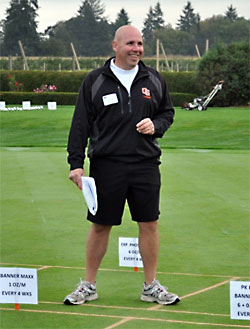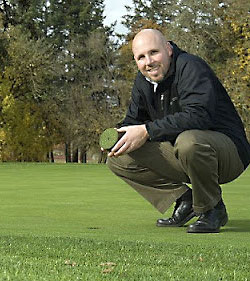|
Golembiewski Leaves Oregon State University...
David Phipps, Stone Creek Golf Club, Oregon City, OR:
 "Last week I received a phone call that I never imagined I would receive. A few years ago the turf community was pondering how they were going to replace Tom Cook at Oregon State University. The Oregon Superintendents came through with $50K to assure Tom's position would be fast tracked in order to keep the program running on a smooth course. I was asked by the University to serve on the selection committee and was overwhelmingly pleased to meet Dr. Rob Golembiewski, who we eventually agreed to offer the position. Dr. Rob and I developed a great friendship and often spoke on the future of the turf program and how it could reach new heights.
 Since coming to Oregon State University, Dr. Golembiewski picked right up where Tom Cook left off and immediately began to develop new programs and interest in research at Oregon State. He began by constructing 50,000 square foot putting green and began trials on michrodochium patch, anthracnose and most notably, a green speed trial that mirrored Tom Nikolai's trial at Michigan State, but only on annual bluegrass instead of creeping bentgrass.
Dr. Golembiewski's impact to the turf community was immediate. In his first year he made over 30 appearances across the Northwest, speaking to various groups on turfgrass management. His enthusiasm was unbelievable and everyone was excited for the future of the turf program at OSU. I know this sounds like a eulogy but rest assured Rob is doing fine and well. The phone call I received was Rob informing me that he had been offered a position with Bayer Crop Science in Columbus, Ohio. Rob didn't have to explain it to me because I knew that eight of his siblings would be close at hand in Michigan and he would be much closer to his family. There was no doubt that the offer must have been pretty sweet as well. It was not an easy decision to make but I know it was right for him and I would have done the same if I were in his shoes.
We will all miss Rob here in the NW and will always look fondly on the impact he had on the turf program within such a short time. Our focus will now go toward preserving the turf program and finding a replacement as soon as possible. I have already been contacted by Anita Green, the department head, and asked to meet with the Dean. It will be imperative to show industry support for the position and to assure them that our support and funding will continue.
 Rob is not the only university professor that has recently been lured away from academia. Most recently, Dr. Frank Wong from UC Davis has gone to Bayer Crop Science, Dr. Lane Tredway from UNCS has gone to Syngenta, and Dr. Eric Miltner from Washington State has gone to Agrium Advanced Technologies. This is a disturbing trend to say the least as far as universities go. Is this a sign of a failing university system that has become so reliant upon outside funding sources that once a turn in the economy, the programs begin to fail? I feel this is a trend that has begun long before this recession. States budgets have become stretched to the point where the idea of a land grant university is a notion of the past.
Dr. Golembiewski has been referred to as a "one man show", which is no exaggeration. Back in the days when I was at Oregon State there was a complete landscape curriculum as well as a turfgrass curriculum. That continued for many years until funding became short and they couldn't retain the landscape professor and he was off to greener pastures. The university needs to offer both programs to retain its viability but the funding is still short for a full time landscape professor. Dr. Golembiewski's position is funded but he is still required to fulfill 125% of a single full time equivalent. (FTE) This is why we still need to raise more funds to enable the university to bring on another position.
Is this a sign of a failing university system that has become so reliant upon outside funding sources that once a turn in the economy, the programs begin to fail? |
The only way universities can retain quality people any more is through endowments. The Oregon State Foundation has been extremely supportive of the superintendents and has helped us set up an endowment for the program. Jack Holpuck of the OSU Foundation has been a great supporter of the turfgrass program and has worked tirelessly to secure funding. In 2008 the Giustina family donated $1 million to endow the faculty position in turf management. Without this donation the program would probably be a wash today.
We are headed into a new chapter of leadership at OSU and I am excited about the new opportunities ahead . Turf programs on the west coast are few and far between, leaving mainly Oregon and Washington State as programs to educate our future superintendents and turfgrass managers.
Rob, I'll miss you.You can move to Ohio but you cannot hide. Our friendship will remain and I'll look forward to spending time together at future GCSAA conferences."
Visit David's blog at stonecreeksuper.blogspot.com.
|